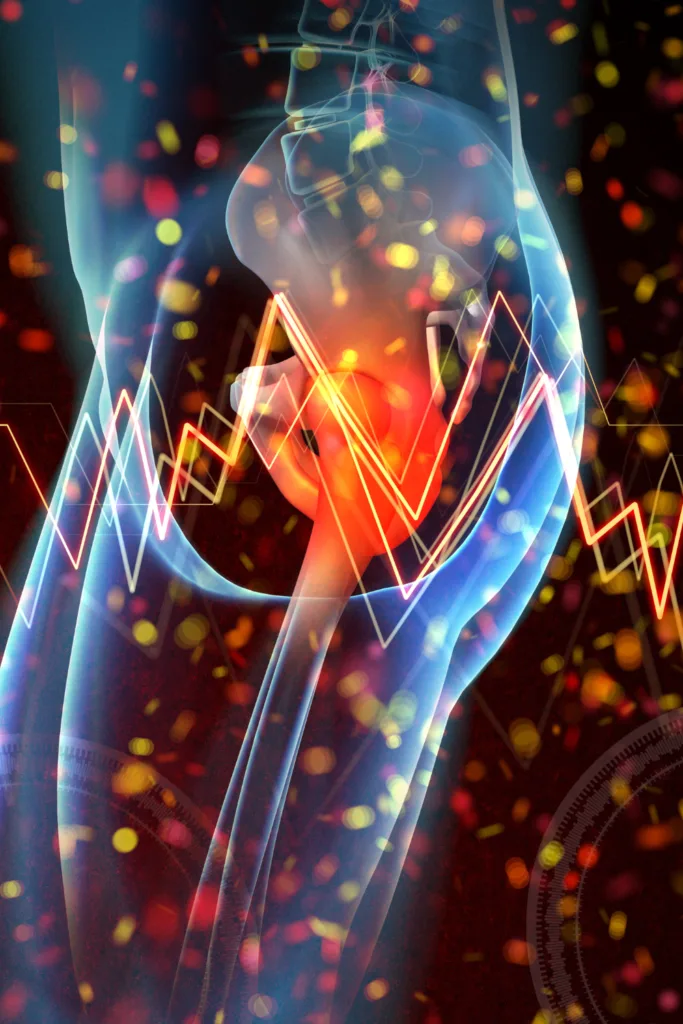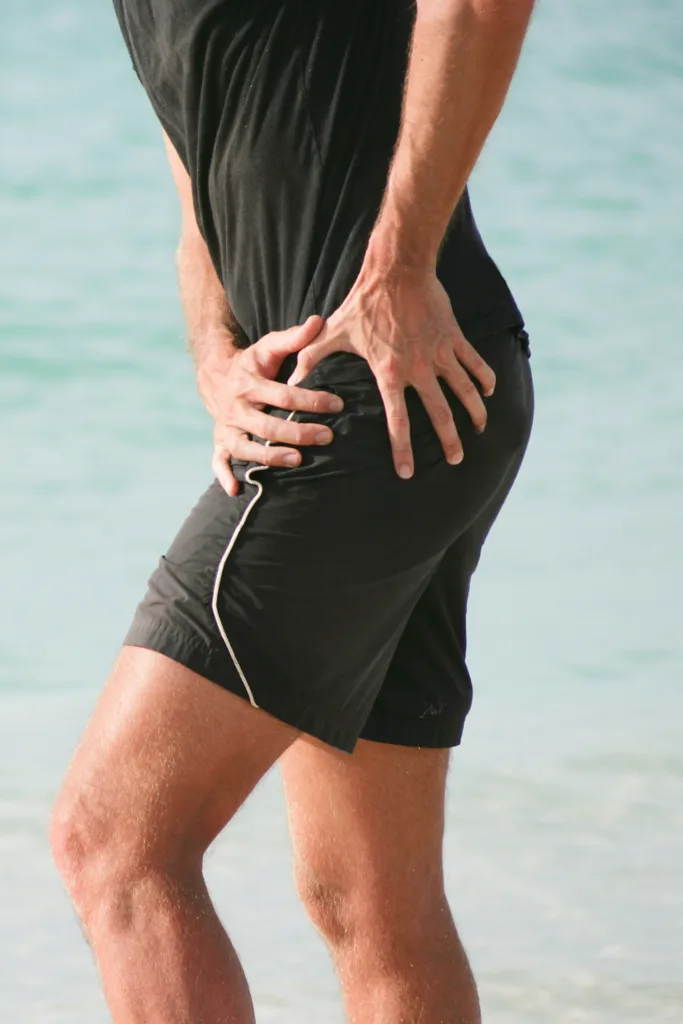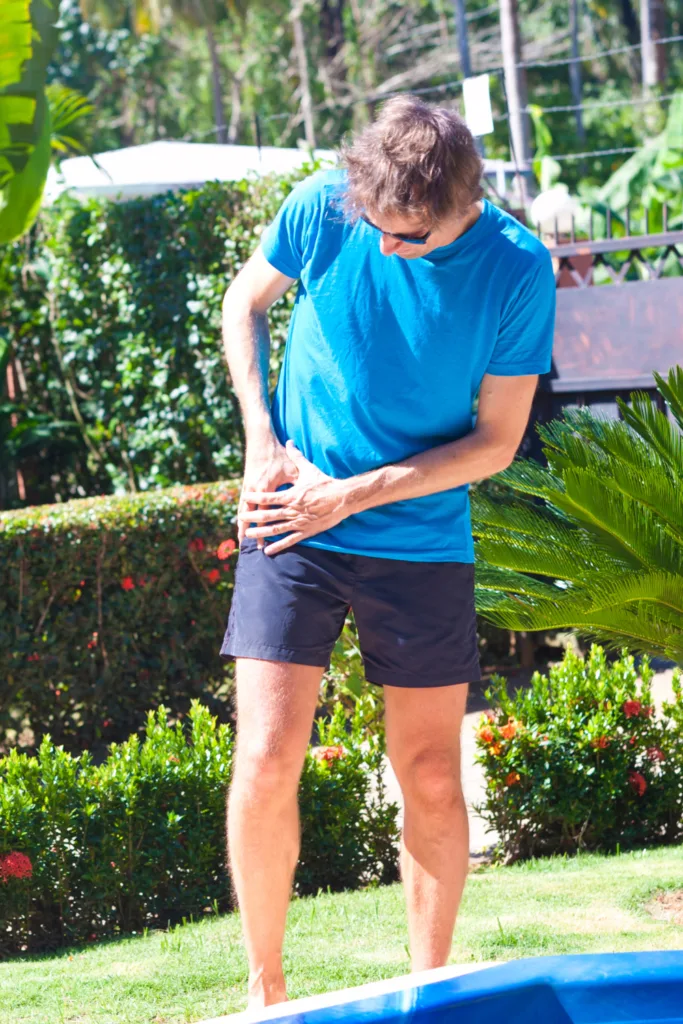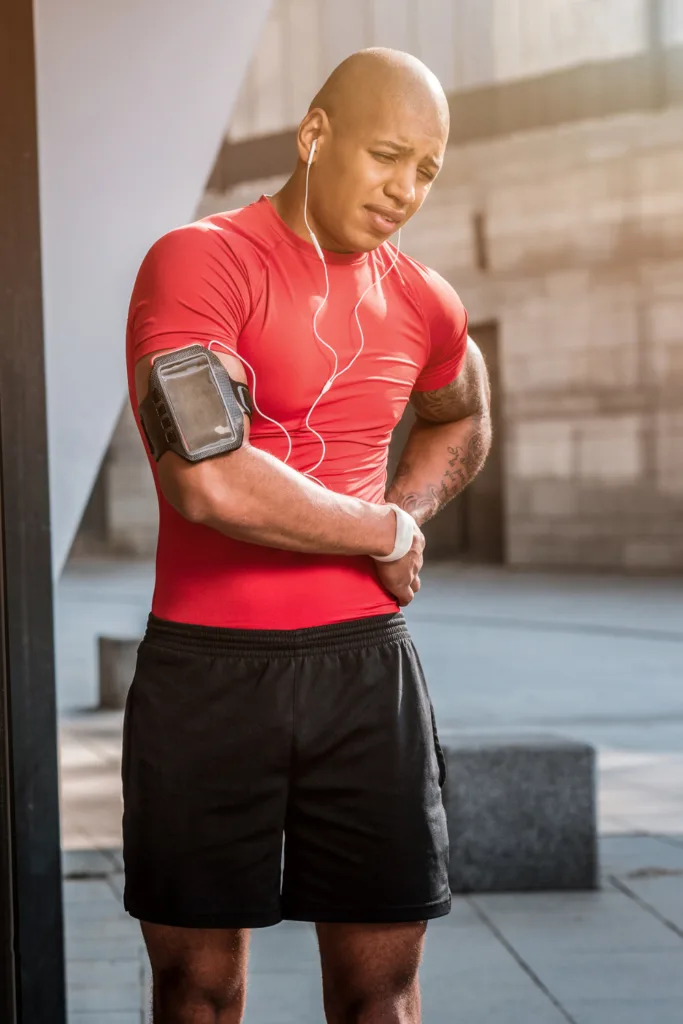Hip pain and soreness is a common concern for runners.
Whilst some strain and soreness after running is normal, if you regularly experience hip pain after running, then it may be a sign that there is something wrong.
Injuries, pulled muscles, inflammation, muscle tears and stress fractures can all be causes of hip pain.
Imbalances in your muscles can also be a common cause of hip, and more commonly, knee pain.
So what exactly causes hip pain after running and what are the best ways to fix it?
In this guide we’ll explore:
- Why your hips are important when running
- What are the hips made up of?
- What causes hip pain after running?
- What are the risk factors for hip pain?
- How to treat hip pain
- How to prevent hip pain after running
Ready?
Let’s go!

Why your hips are important when running
Before we go into the causes of hip pain after running, it’s useful to explain why your hips are important when running.
Many running coaches will tell you that proper running form starts with the pelvis and glutes.
Whilst elements of running form like foot strike are still important, by shifting our focus to the hips and glutes, we can address where running stride begins.
The foot strike is the end result of so many other things happening further up the kinetic chain.
Ultimately, the core and hips are where every runner should be starting if they are concerned when improving their running form, increasing their speed and minimising the risk of injury.
The hips have two key functions: to provide balance and drive.
Whilst our core torsos balance on our hips, the hips play an important role as leg levers to drive our bodies forward.
The bottom line? If the hips are not working properly, the legs are unable to provide optimal speed and power.
Related: Proper running foot strike and ways to improve it
What are the hips made up of?
The hip joint itself is made up of the top of the thigh bone, where it sits inside a socket within the pelvis.
This joint is what allows you to bear weight on your legs as well as allowing for motion and stability.
In fact, the hip joint is one of the most stable joints in the body.
The ligaments in the hip play an important role in preventing hyperextension, preventing dislocation and reinforcing the hip joint.
There are also many muscles that rely on the hip joint. These include:
- Hip flexors and hip extensors. These muscles move your leg forward and backward and are heavily used when running. These muscles work hard when you sprint or run uphill. The hip extensors work with the hip flexors to maintain a neutral pelvis and allow for a powerful and safe range of motion through the hip.
- Hip adductors and hip abductors. These muscles move your leg towards and away from your body to the side. They help to stabilise your pelvis and thighs when running. These muscles are used mostly when you run uphill or downhill.
- Hamstrings. These muscles are on the back of your thighs. The hamstrings play an important role to push against the ground and develop the force to push your foot off the ground. Two thirds of force production comes from the glutes, whilst one third comes from the hamstrings.
- Internal and external rotators. These muscles perform internal and external hip rotation. They are important stabilisers and help control pelvic movement. These muscles stabilise the hip joint so larger muscles like the gluteus maximus can work.

What causes hip pain after running?
Hip pain after running can be caused by a variety of conditions.
If you experience hip pain after running, then it’s important you identify the cause before continuing running. If you ignore the pain, it could become more painful and you risk making the injury worse.
Hip pain can also cause additional injuries in your lower body (in the lower kinetic chain) as your body tries to compensate for the pain. Shin pain, knee pain and ankle pain can all be caused by hip pain.
Here are seven common causes of hip pain after running:
#1 Pulled or strained muscles
‘Pulled’ muscles, or muscle strains, are a common side effect of running. If you’re training too much or take sudden jumps in your training, then this can cause tiny tears to develop in your muscles.
Strains in your glutes (your buttocks) can cause hip pain. When this happens, you will most likely feel pain on the outside or at the back of your hip.
#2 Osteoarthritis
Osteoarthritis is a condition that occurs when the padding (the cartilage) between your bones and joints gradually wears away, causing your bones to rub against each other which can be incredibly painful.
This condition develops over time and is more commonly seen in elderly people. It also tends to run in families.
#3 Tendonitis
Tendonitis is when a tendon swells and becomes inflamed after a tendon injury. It can cause joint pain, stiffness and affect how the tendon moves.
This condition typically occurs if you overtrain and don’t allow enough time for recovery between runs.
There are several tendons in the hip, including the hip flexors, hip adductors and hamstrings, and tendonitis can occur in any of them.
#4 Bursitis
Bursitis is a painful condition that affects the small, fluid-filled sacs (called ‘bursae’) that cushion the bones, tendons and muscles near your joints.
The condition occurs when the bursae become inflamed from repeated pressure or friction.
There are two types of bursae that can cause hip pain after running:
- Trochanteric bursitis causes pain behind the boney part of your hip at the top of your thigh, below your pelvis. Pain from trochanteric bursitis is often worse at night.
- Iliopsoas bursitis causes pain in the front of your hip, near your groin. It is less common than trochanteric bursitis.
#5 Hip stress fracture
Hip stress fractures are tiny cracks in your bone that develop from repetitive stress, such as running.
With a stress fracture, you typically develop pain in the front of your hip and groin, and the pain tends to get worse when walking or running.
Severe stress fractures can cause pain all the time.
#6 Labral tears
The labrum is strong, flexible cartilage that lines the hip joint socket.
After repeated use, the cartilage can become inflamed or tear which can lead to a sharp pain when running.
You may also feel a dull ache when resting or sleeping.
#7 IT band syndrome
IT band syndrome is a common running injury that affects the thick band of connective tissue that runs along your outer thigh to just below your knee at the side of your shin.
When inflamed, the IT band can cause tightness, pain and friction at the knee and hip joint and is therefore a common cause of hip pain after running.
#8 Nerve entrapment syndrome
Nerve entrapment syndrome is a medical syndrome which develops when nerves become compressed and restricted.
This occurs due to a variety of reasons, including trauma, injury and repeated overuse.
According to a 2017 study, the sciatic, pudendal, obturator, femoral and lateral femoral cutaneous nerves can become entrapped and cause hip pain in athletes.
Manual therapy, stretching, strengthening exercises and aerobic conditioning can all be used to provide treatment.
#9 Pregnancy
Hip pain can also be caused by pregnancy or running during the postpartum period.
According to VDOT-02 certified running coach Whitney Heins over at The Mother Runners, if you’re pregnant “the weight of the baby can pull your hips forward causing imbalances. Your hips could also hurt due to the pressure of your growing uterus.”

What are the risk factors for hip pain?
There are several risk factors when it comes to hip pain after running:
- Muscle imbalances
- Weak, underused or tight muscles
- Not warming up before a run
- Sudden increases in mileage
- Excessive speed training or hill running
- Overstriding
- Overtraining
- Running on uneven or sloped surfaces
- Running in ill-fitting or worn out running shoes
- Insufficient rest and recovery in between runs
- Poor running form
How to treat hip pain
The good news is that many hip pain after running injuries can be treated, especially if you address the symptoms early.
According to a 2005 study, hip pain treatment for runners should focus not only on addressing the symptoms but also identifying the underlying conditions that precipitated the injury.
The study adds that: “Coaches, trainers and medical personnel who care for runners should advocate running regimes, surfaces, shoes, technique and individualised training programmes that minimise the risk of initial or recurrent hip injuries.”
Here are six ways to treat hip pain after running:
#1 Ice and rest
Apply ice to your hip as soon as you are able to.
Keep the ice pack on your hip for roughly 15-20 minutes at a time every 1-2 hours to help reduce pain and inflammation.
#2 Avoid strenuous exercise
Keep the weight off your hip where possible and avoid any strenuous exercise.
Aim to do gentle exercises such as yoga to help decrease stiffness.
If you have a hip stress fracture, your health professional may advise you to use crutches until the fracture has had time to heal.
#3 Do physical therapy
Physical therapy can help to address the pain and analyse what is contributing to your hip problems.
Poor running form and technique, for example, are risk factors for hip pain after running, so a physical therapist will help to identify problem areas and weaknesses and put a plan in place to address them.
#4 Take medication
Over the counter medications and prescription medications can help relieve pain and inflammation and are often used to treat hip injuries.
If in doubt, speak to your healthcare professional.
#5 Take injections
If medication is not effective, your healthcare professional may advise anti-inflammatory injections to treat conditions like tendonitis, bursitis and osteoarthritis.
Corticosteroids are strong anti-inflammatory medications that are commonly used to treat such conditions.
Hyaluronic acid injections are also used to help lubricate the hip joint and decrease stiffness.
#6 Surgery
Severe hip injuries may require surgery, particularly if you have torn a muscle or tendon significantly.
Severe muscle tears and advanced osteoarthritis in the hip are often treated with surgery.
Related: 5 easy and dynamic hip flexor stretches for runners

How to prevent hip pain after running
There are many ways to prevent hip pain and runners should use the following practices in their weekly training routine to ensure they prevent hip pain for good.
Here are 8 ways to prevent hip pain after running:
#1 Remember to warm up
A warm up will help to mobilise and ‘warm up’ your muscles and joints before a run and help reduce the risk of injury.
Aim to do 15-20 minutes of jogging followed by some dynamic stretches before heading out for your run.
#2 Get some new running shoes
A decent pair of well-fitting running shoes are a must for any runner. If you run in ill-fitting or worn out running shoes, this can increase your risk of running injuries like hip pain, shin pain and IT band pain.
Visit your local running shoe store and get fitted for a pair of running shoes. Check out my guide on how to find the right running shoes for more tips and advice.
#3 Run on even surfaces
If you regularly experience hip pain and run on uneven terrain or sloped surfaces then now is the time to find an even, flat surface to run on.
When you run on an uneven surface, you put extra stress on your hips and knees.
Aim to run on a level surface such as a road, track or treadmill until the pain subsides.
#4 Eat the right foods
Food and nutrition is important for every runner looking to stay strong and healthy.
Fuel your runs properly and make sure you are consuming the right amounts of carbs, protein, healthy fats and vitamins and minerals.
If in doubt, speak to your healthcare professional or a nutritionist.
#5 Start slowly and progress gradually
Sudden increases in mileage or activities like speed training can do more harm than good.
Overtraining can also put you at a greater risk of developing common running injuries like hip pain after running.
If you are training for a race, make sure you are increasing your mileage incrementally by roughly 10% each week.
A well-rounded training plan will account for this incremental increase.
#6 Strength train
When performed consistently, strength training can help to strengthen muscles, bones and joints, improve running form and economy and decrease the risk of injury.
If you suffer with weak hips or glutes, then consider incorporating strength training into your training routine.
Aim to do 2-3 strength training sessions per week. Strength training for runners should target the core, legs and arms.
Hip and glute strengthening exercises like squats and deadlifts are particularly useful for runners looking to improve their hip strength.
#7 Stretch and foam roll
Stretching is essential for any runner suffering with tight, stiff or sore muscles after running.
Aim to stretch daily and incorporate cross training exercises like yoga and Pilates into your training routine.
Hip mobility exercises like hip circles, donkey kicks and hip flexor stretch are great to do as part of a daily stretching routine.
Foam rolling is also a great way to increase mobility and flexibility.
#8 Work on your running form
Proper running form is important when it comes to running in the most efficient way possible.
As discussed at the start of this guide, proper running form and posture and injury prevention comes down to running hip position.
Ask yourself: what are your hips and pelvis doing when you run?
Your running stride will depend on a stable, neutral pelvis to allow your leg to fully extend behind you so that it can pull forward into the next stride.
If your pelvis is tilted backwards (posterior) or forwards (anterior), this can be detrimental to your hip posture and overall running gait.
Work on your running form by including running drills in your warm up that focus on your hip position and posture.
- 5 things I wish I’d known before returning to running - March 3, 2024
- Running 20 minutes a day: Benefits + how to start - January 27, 2024
- How to run your first 2 hour half marathon - January 16, 2024
